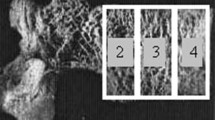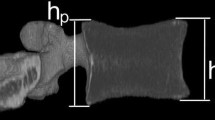Abstract
Summary
The correlations between the failure load of 20 T12 vertebral bodies, their patient-mode high-resolution peripheral quantitative computed tomography (HR-pQCT) indices, and the L1 areal bone mineral density (aBMD) were investigated. For the prediction of the T12 vertebral failure load, the T12 HR-pQCT microarchitectural parameters added significant information to that of L1 aBMD and to that of cortical BMD, but not to that of T12 vertebral BMD and not to that of T12 trabecular BMD.
Introduction
HR-pQCT is a new in vivo imaging technique for assessing the three-dimensional microarchitecture of cortical and trabecular bone at the distal radius and tibia. But little is known about this technique in the direct measurement of vertebral body.
Methods
Twenty female donors with the mean age of 80.1 (7.6) years were included in the study. Dual X-ray absorptiometry of the lumbar spine and femur was performed. The spinal specimens (T11/T12/L1) were dissected, scanned using HR-pQCT scanner, and mechanically tested under 4° wedge compression. The L1 aBMD, T12 patient-mode HR-pQCT indices, and T12 vertebral failure loads were analyzed.
Results
For the prediction of vertebral failure load, the inclusion of BV/TV into L1 aBMD was the best model (R 2 = 0.52), Tb.N and Tb.Sp added significant information to the L1 aBMD and to the cortical BMD, but none of the vertebral microarchitectural parameters yielded additional significant information to the trabecular BMD (or BV/TV) and to the vertebral BMD.
Conclusion
Vertebral microarchitectural parameters obtained from the patient-mode HR-pQCT analysis provide significant information on bone strength complementary to that of aBMD and to that of cortical BMD, but not to that of vertebral BMD and not to that of trabecular BMD.




Similar content being viewed by others
References
Lips P, Cooper C, Agnusdei D, Caulin F, Egger P, Johnell O, Kanis JA, Kellingray S, Leplege A, Liberman UA, McCloskey E, Minne H, Reeve J, Reginster JY, Scholz M, Todd C, De Vernejoul MC, Wiklund I (1999) Quality of life in patients with vertebral fractures: validation of the quality of life questionnaire of the European Foundation for Osteoporosis (QUALEFFO). Osteoporos Int 10:150–160
Krause M, Breer S, Mohrmann B, Vettorazzi E, Marshall RP, Amling M, Barvencik F (2013) Influence of non-traumatic thoracic and lumbar vertebral fractures on sagittal spine alignment assessed by radiation-free spinometry. Osteoporos Int 24(6):1859–1868
Christenson ES, Jiang X, Kagan R, Schnatz P (2012) Osteoporosis management in post-menopausal women. Minerva Ginecol 64(3):181–194
Lochmüller EM, Bürklein D, Kuhn V, Glaser C, Müller R, Glüer CC, Eckstein F (2002) Mechanical strength of the thoracolumbar spine in the elderly: prediction from in situ dual-energy X-ray absorptiometry, quantitative computed tomography (QCT), upper and lower limb peripheral QCT, and quantitative ultrasound. Bone 31(1):77–84
Ebbesen EN, Thomsen JS, Beck-Nielsen H, Nepper-Rasmussen HJ, Mosekilde L (1999) Lumbar vertebral body compressive strength evaluated by dual-energy X-ray absorptiometry, quantitative computed tomography and ashing. Bone 25(6):713–724
Roux JP, Wegrzyn J, Arlot ME, Guyen O, Delmas PD, Chapurlat R, Bouxsein ML (2010) Contribution of trabecular and cortical components to biomechanical behaviour of human vertebrae: an ex vivo study. J Bone Miner Res 25(2):356–361
Wegrzyn J, Rous JP, Arlot ME, Boutroy S, Vilayphiou N, Guyen O, Delmas PD, Chapurlat R, Bouxsein ML (2010) Role of trabecular microarchitecture and its heterogeneity parameters in the mechanical behaviour of ex vivo human L3 vertebrae. J Bone Miner Res 25(11):2324–2331
Hulme PA, Boyd SK, Ferguson SJ (2007) Regional variation in vertebral bone morphology and its contribution to vertebral fracture strength. Bone 41:946–957
Marangalou HJ, Eckstein F, Kuhn V, Ito K, Cataldi M, Taddei F, van Rietbergen B (2014) Locally measured microstructural parameters are better associated with vertebral strength than whole bone density. Osteoporos Int 25:1285–1296
Wegrzyn J, Roux JP, Arlot ME, Boutroy S, Vilayphiou N, Guyen O, Delmas PD, Chapurlat R, Bouxsein ML (2011) Determinants of the mechanical behaviour of human lumbar vertebrae after simulated mild fracture. J Bone Miner Res 26(4):739–746
Hussein AI, Morgan EF (2013) The effect of intravertebral heterogeneity in microstructure on vertebral strength and failure patterns. Osteoporos Int 24:979–989
Krause M, Museyko O, Breer S, Wulff B, Duckstein C, Vettorazzi E, Glueer C, Pueschel K, Engelke K, Amling M (2014) Accuracy of trabecular structure by HR-pQCT compared to gold standard μCT in th radius and tibia of patients with osteoporosis and long-term bisphosphonate therapy. Osteoporos Int. doi:10.1007/s00198-014-2650-4
Liu XS, Cohen A, Shane E, Yin PT, Stein EM, Rogers H, Kokolus SL, McMahon DJ, Lappe JM, Recker RR, Lang T, Guo XE (2010) Bone density, geometry, microstructure, and stiffness: relationships between peripheral and central skeletal sites assessed by DXA, HR-pQCT, and cQCT in premenopausal women. J Bone Miner Res 25:2229–2238
MacNeil JA, Boyd SK (2007) Accuracy of high-resolution peripheral quantitative computed tomography for measurement of bone quality. Med Eng Phys 29(10):1096–1105
Tjong W, Kazakia GJ, Burghardt AJ, Majumdar S (2012) The effect of voxel size on high-resolution peripheral computed tomography measurement of trabecular and cortical bone microstructure. Med Phys 39(4):1893–1903
Cohen A, Dempster DW, Mueller R, Guo XE, Nickolas TL, Liu XS, Zhang XH et al (2010) Assessment of trabecular and cortical architecture and mechanical competence of bone by high-resolution peripheral computed tomography: comparison with transiliac bone biopsy. Osteoporos Int 21:263–273
Cockerill W, Ismail AA, Cooper C, Matthis C, Raspe H, Silman AJ, O’Neill TW (2000) Does location of vertebral deformity within the spine influence back pain and disability? European Vertebral Osteoporosis Study (EVOS) Group. Ann Rheum Dis 59(5):368–371
Skrzypiec DM, Bishop NE, Klein A, Pueschel K, Morlock MM, Huber G (2013) Estimation of shear load sharing in moderately degenerated human lumbar spine. J Biomech 46(4):651–657
Hongo M, Gay RE, Hsu JT, Zhao KD, Ilharreborde B, Berglund LJ, An KN (2008) Effect of multiple freeze–thaw cycles on intervertebral dynamic motion characteristics in the porcine lumbar spine. J Biomech 41(4):916–920
Nachemson A (1966) The load on lumbar disks in different positions of the body. Clin Orthop Relat Res 45:107–122
Brinckmann P, Biggemann M, Hilweg D (1989) Prediction of the compressive strength of human lumbar vertebrae. Clin Biomech 4(2):1–27
Laib A, Ruegsegger P (1999) Calibration of trabecular bone structure measurements of in vivo three-dimensional peripheral quantitative computed tomography with 28-micron-resolution microcomputed tomography. Bone 24:35–39
Boutroy S, Bouxsein ML, Munoz F, Delmas PD (2005) In vivo assessment of trabecular bone microarchitecture by high-resolution peripheral quantitative computed tomography. J Clin Endocrinol Metab 90:6508–6515
Hildebrand T, Ruegsegger P (1997) A new method for the model independent assessment of thickness in three-dimensional images. J Microsc 185:67–75
Buckley JM, Loo K, Motherway J (2007) Comparison of quantitative computed tomography-based measures in predicting vertebral compressive strength. Bone 40:767–774
Hansen S, Jensen JE, Ahrber F, Hauge EM, Brixen K (2011) The combination of structural parameters and areal bone mineral density improves relation to proximal femur strength: an in vitro study with high-resolution peripheral quantitative computed tomography. Calcif Tissue Int 89:335–346
Pistoia W, van Rietbergen B, Lochmüller EM, Lill CA, Eckstein F, Rüegsegger P (2002) Estimation of distal radius failure load with micro-finite element analysis models based on three-dimensional peripheral quantitative computed tomography images. Bone 30(6):842–848
Rao RD, Singrakhia MD (2003) Painful osteoporotic vertebral failure: pathogenesis, evaluation, and roles of vertebroplasty and kyphoplasty in its management. J Bone Joint Surg Am 85(10):2010–2022
Hussein AI, Mason ZD, Morgan EF (2013) Presence of intervertebral discs alters observed stiffness and failure mechanisms in the vertebra. J Biomech 46:1683–1688
Adams MA, Pollintine P, Tobias JH, Wakley GK, Dolan P (2006) Intervertebral disc degeneration can predispose to anterior vertebral failures in the thoracolumbar spine. J Bone Miner Res 21(9):1409–1416
Nekkanty S, Yerramshetty J, Kim D, Zauel R, Johnson E, Cody DD, Yeni YN (2010) Stiffness of the endplate boundary layer and endplate surface topography are associated with brittleness of human whole vertebral bodies. Bone 47(4):783–789
Pollintine P, Dolan P, Tobias JH, Adams MA (2004) Intervertebral disc degeneration can lead to ‘stress-shielding’ of the anterior vertebral body: a cause of osteoporotic vertebral failure? Spine 29(7):774–782
Maquer G, Schwiedrzik J, Zysset PK (2012) Embedding of human vertebral bodies leads to higher ultimate load and altered damage localisation under axial compression. Comput Methods Biomech Biomed Engin. doi:10.1080/10255842.2012.744400
Bürklein D, Lochmüller EM, Kuhn V, Grimm J, Barkmann R, Müller R, Eckstein F (2001) Correlation of thoracic and lumbar vertebral failure loads with in situ vs. ex situ dural energy X-ray absorptionmetry. J Biomech 35:579–587
O’Neill TW, Felsenberg D, Varlow J, Cooper C, Kanis JA, Silman AJ (1996) The prevalence of vertebral deformity in European men and women: the European Vertebral Osteoporosis Study. J Bone Miner Res 11:1010–1018
Lochmüller EM, Pöschl K, Würstlin L, Matsuura M, Müller R, Link TM, Eckstein F (2008) Does thoracic or lumbar spine bone architecture predict vertebral failure strength more accurately than density? Osteoporos Int 19:537–545
Buckley JM, Kuo CC, Cheng LC, Loo K, Motherway J, Slyfield C, Deviren V, Ames C (2009) Relative strength of thoracic vertebrae in axial compression versus flexion. Spine J 9:478–485
McDonnell P, Harrison N, McHugh PE (2010) Investigation of the failure behaviour of vertebral trabecular architectures under uni-axial compression and wedge action loading conditions. Med Eng Phys 32(6):569–576
Kolb JP, Kueny RA, Püschel K, Boger A, Rueger JM, Morlock MM, Huber G, Lehmann W (2013) Does the cement stiffness affect fatigue fracture strength of vertebrae after cement augmentation in osteoporotic patients? Eur Spine J 22(7):1650–1656
Berlemann U, Ferguson SJ, Nolte LP, Heini PF (2002) Adjacent vertebral failure after vertebroplasty. A biomechanical investigation. J Bone Joint Surg (Br) 84:748–752
Baroud G, Nemes J, Heini P, Steffen T (2003) Load shift of the intervertebral disc after vertebroplasty: a finite element study. Eur Spine J 12(4):421–426
Hulme PA, Boyd SK, Heini PF, Ferguson SJ (2009) Differences in endplate deformation of the adjacent and augmented vertebra following cement augmentation. Eur Spine J 18(5):614–623
Kayanja MM, Evans K, Milks R, Lieberman IH (2006) Adjacent level load transfer following vertebral augmentation in the cadaveric spine. Spine 31:E790–E797
Bonnick SL (1998) Bone densitometry in clinical practice: application and interpretation. Humana, Totowa, New Jersey
Dall’Ara E, Varga P, Pahr D, Zysset P (2011) A calibration methodology QCT BMD for human vertebral body with registered micro-CT images. Med Phys 38:2602–2608
Acknowledgments
This study was financially supported by the German Federal Ministry of Education and Research (BMBF) through the consortium “BioAsset” (Grant number 01EC1005). The authors also would like to acknowledge Birgit Wulff for harvesting the donors and counseling the next of kin.
Conflicts of interest
None.
Author information
Authors and Affiliations
Corresponding author
Additional information
Yongtao Lu and Matthias Krause contributed equally to this work and therefore share the first authorship.
Rights and permissions
About this article
Cite this article
Lu, Y., Krause, M., Bishop, N. et al. The role of patient-mode high-resolution peripheral quantitative computed tomography indices in the prediction of failure strength of the elderly women’s thoracic vertebral body. Osteoporos Int 26, 237–244 (2015). https://doi.org/10.1007/s00198-014-2846-7
Received:
Accepted:
Published:
Issue Date:
DOI: https://doi.org/10.1007/s00198-014-2846-7




